Overview
The article emphasizes the critical role of land parceling and subdivision in real estate development, outlining its significance and the necessary steps for successful land subdivision. It delivers a thorough overview by detailing:
- Legal requirements
- Financial considerations
- The integration of technology to enhance efficiency
A comprehensive understanding of these elements is essential, as it can lead to profitable outcomes in property development.
Introduction
The process of land parceling and subdivision is a pivotal element in real estate development, transforming vast tracts of land into valuable, marketable parcels. Understanding the intricacies of this procedure allows stakeholders to unlock significant financial opportunities and elevate property values. However, navigating the complexities of zoning laws, legal requirements, and potential costs presents a formidable challenge. Consequently, how can one ensure a successful subdivision while maximizing returns and adhering to regulations?
Understand Land Subdivision Basics
The overview of land parceling and subdivision highlights land subdivision as a critical legal procedure that involves dividing a single parcel of land into two or more smaller sections for various purposes, including sale, development, or other uses. This process is indispensable for real estate development and can significantly elevate property value. For example, subdividing a 5-acre lot into five 1-acre lots can yield substantial revenue, often surpassing initial investment costs. Typically, the land division process requires 2 to 6 months and incurs expenses ranging from $5,000 to over $50,000, depending on location and infrastructure needs.
Key terms to grasp include:
- Parcel: A defined piece of land that can be sold or developed.
- Plat: A map that delineates the partition of terrain, illustrating the arrangement of lots, streets, and other features.
- Zoning: Rules that dictate how territory can be utilized, significantly impacting development opportunities.
Understanding these fundamentals is essential for real estate professionals, as it provides an overview of land parceling and subdivision, laying the groundwork for navigating the complexities of the subdivision process. Successful case studies in real estate development demonstrate that a thorough comprehension of property parcels and zoning can lead to more profitable outcomes and informed decision-making. As emphasized by Prime Land Buyers, "The potential profit from selling or developing multiple lots is far greater," highlighting the financial advantages of subdividing property.
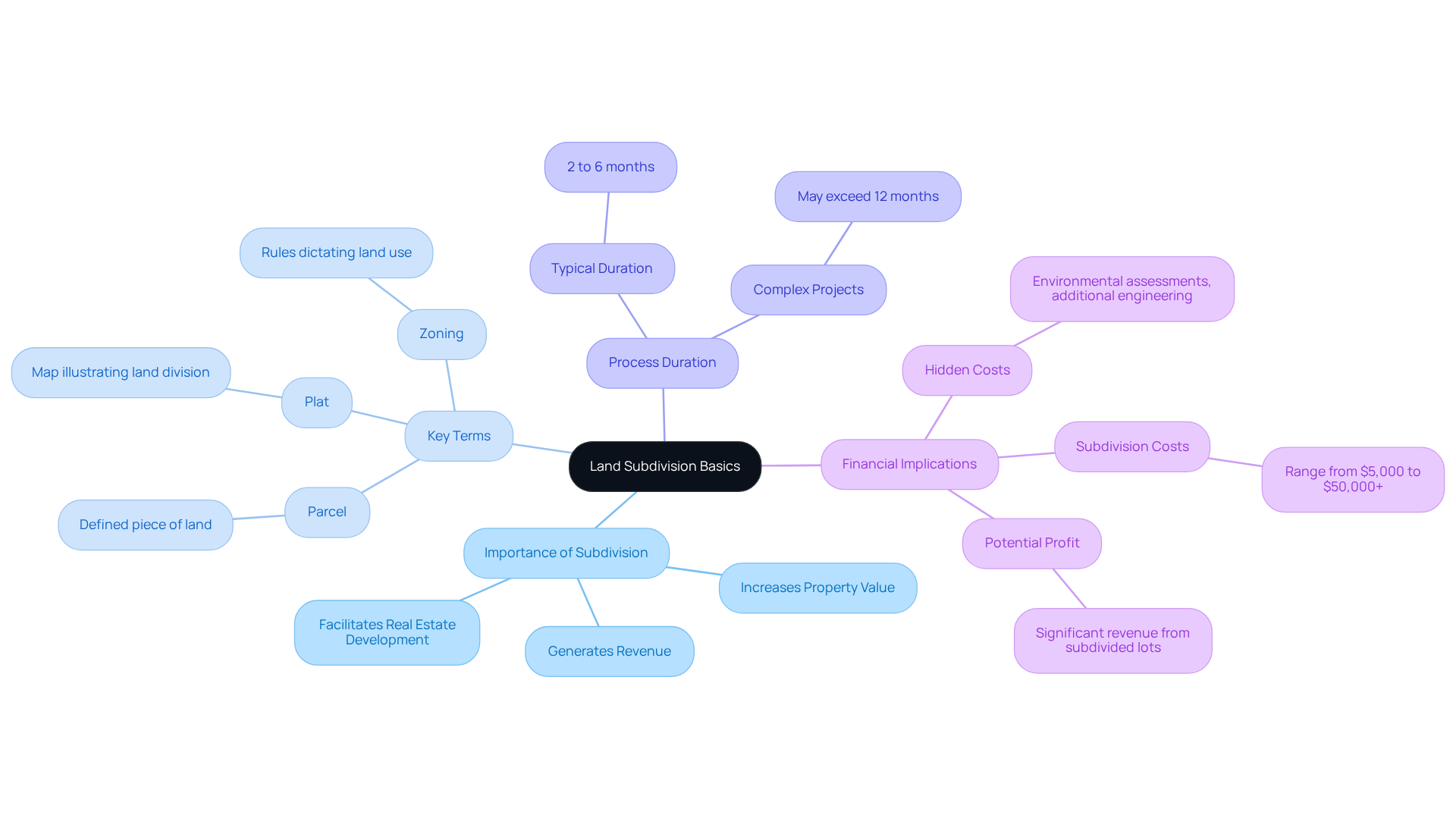
Follow the Step-by-Step Subdivision Process
To successfully subdivide land, it is essential to follow these steps:
- Conduct a Feasibility Study: Begin by evaluating whether your property can be subdivided in accordance with local zoning laws and regulations. This may necessitate consulting with local planning authorities to ensure compliance.
- Develop a Subdivision Plan: Formulate a comprehensive plan that delineates how the land will be divided. This plan should provide an overview of land parceling and subdivision, including a plat map that illustrates the proposed layout of lots and any necessary infrastructure.
- Obtain Required Permits: Request a plat approval permit from your local government. This critical step offers an overview of land parceling and subdivision to ensure that your plans align with local regulations, paving the way for subsequent actions.
- Hire Professionals: Engage a surveyor to produce an accurate survey of the property, along with a civil engineer to assist in the planning of infrastructure. Their expertise is invaluable in providing an overview of land parceling and subdivision complexities.
- Submit Your Plans for Approval: Present your development plan to the local planning board for thorough review. Be prepared to make adjustments based on their feedback, as this collaborative process provides an overview of land parceling and subdivision, which is vital for success.
- Complete the Subdivision: Upon receiving approval, file the new plat with the local property records office. This final step officially establishes the new lots, marking the culmination of your subdivision efforts.
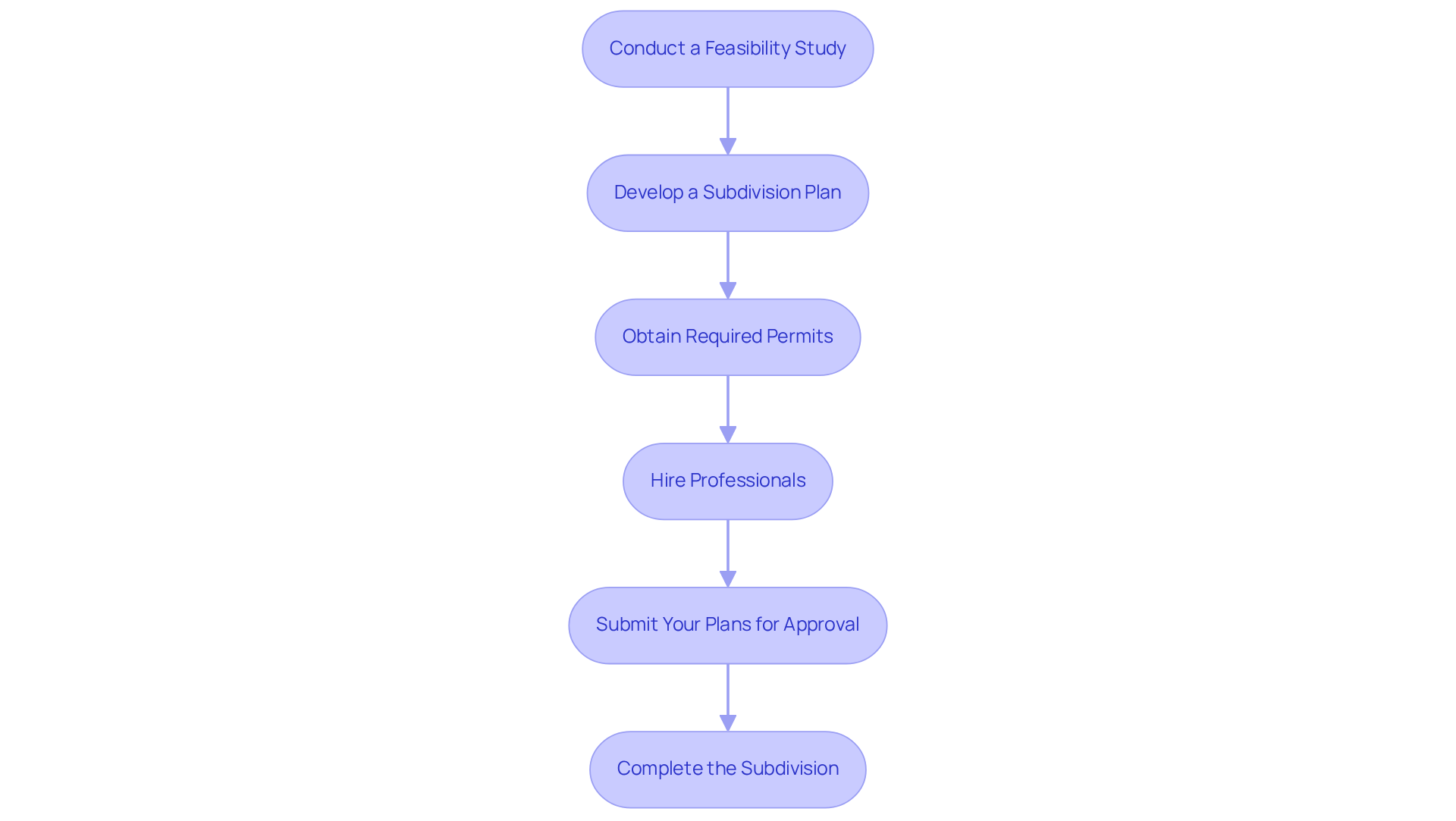
Meet Legal and Zoning Requirements
Meeting legal and zoning requirements is crucial for successful development. Key considerations include the following:
- Zoning Laws: It is imperative to check local zoning ordinances to ascertain the types of developments permitted on your property. Zoning laws dictate essential aspects such as minimum lot size, density, and land use.
- Environmental Regulations: Be vigilant regarding environmental regulations that could influence your development, including wetlands protection and floodplain management.
- Building Codes: Your development plan must comply with local building codes, which govern the construction of any structures on the new lots.
- Public Hearings: Prepare to attend public hearings where community members can express their opinions on your subdivision plans. Engaging with the community can facilitate a smoother approval process.
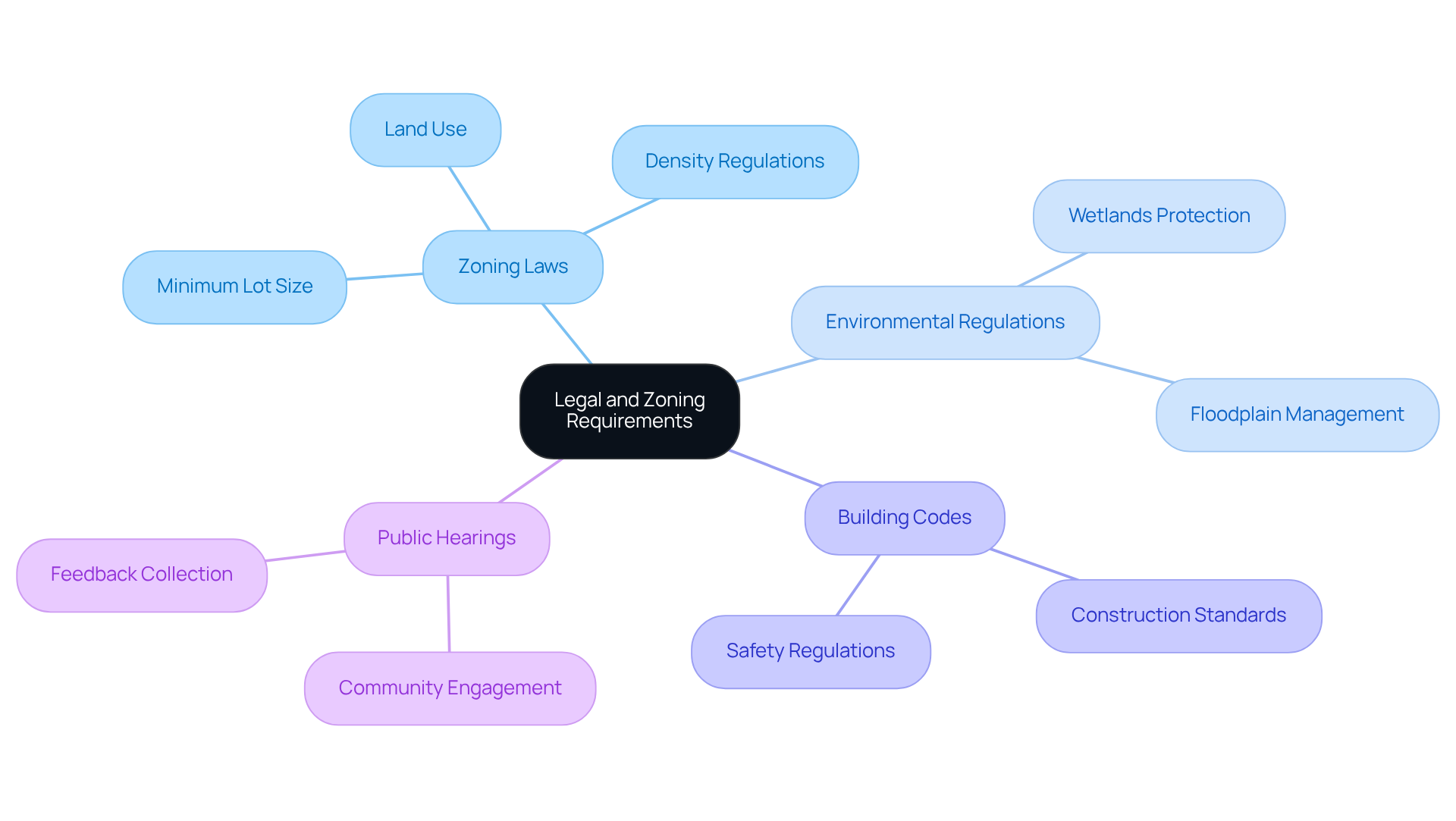
Evaluate Costs and Financial Benefits
An overview of land parceling and subdivision requires evaluating the costs and financial benefits of subdividing land for informed decision-making. Key considerations include:
- Initial Costs: These encompass surveying fees, typically ranging from $2,000 to $5,000, application fees for permits from $1,000 to $5,000, and expenses related to hiring professionals such as engineers and planners. Basic costs for subdividing generally range from $10,000 to $50,000, depending on the complexity of the project.
- Infrastructure Costs: If your subdivision necessitates new roads, utilities, or other infrastructure, these costs must be incorporated into your budget. Proper planning for these expenses can significantly impact the overall financial outcome.
- Possible Income: Evaluate the possible income from selling divided parcels by investigating local market trends. For example, dividing a 5-acre parcel into five one-acre sections can generate over $500,000 in sales revenue against a $30,000 expense, emphasizing the substantial return on investment.
- Return on Investment (ROI): Determine your anticipated ROI by contrasting the overall expenses of the development against the expected revenue from selling the parcels. Comprehending the ROI is essential for encouraging investment in development projects, as smaller lots are often more attractive and economical to potential purchasers. This financial analysis will help determine the project's viability and profitability.
- Contingency Fund: It is advisable to allocate a contingency fund of 10% to 15% of the expected budget to handle unexpected expenses during the development process. This proactive approach can help mitigate financial risks.
- Tax Implications: Be aware of potential tax consequences associated with subdividing property, including federal gift tax considerations, which may affect your overall financial strategy.
Integrating these elements will provide a more comprehensive overview of land parceling and subdivision in relation to the financial landscape.
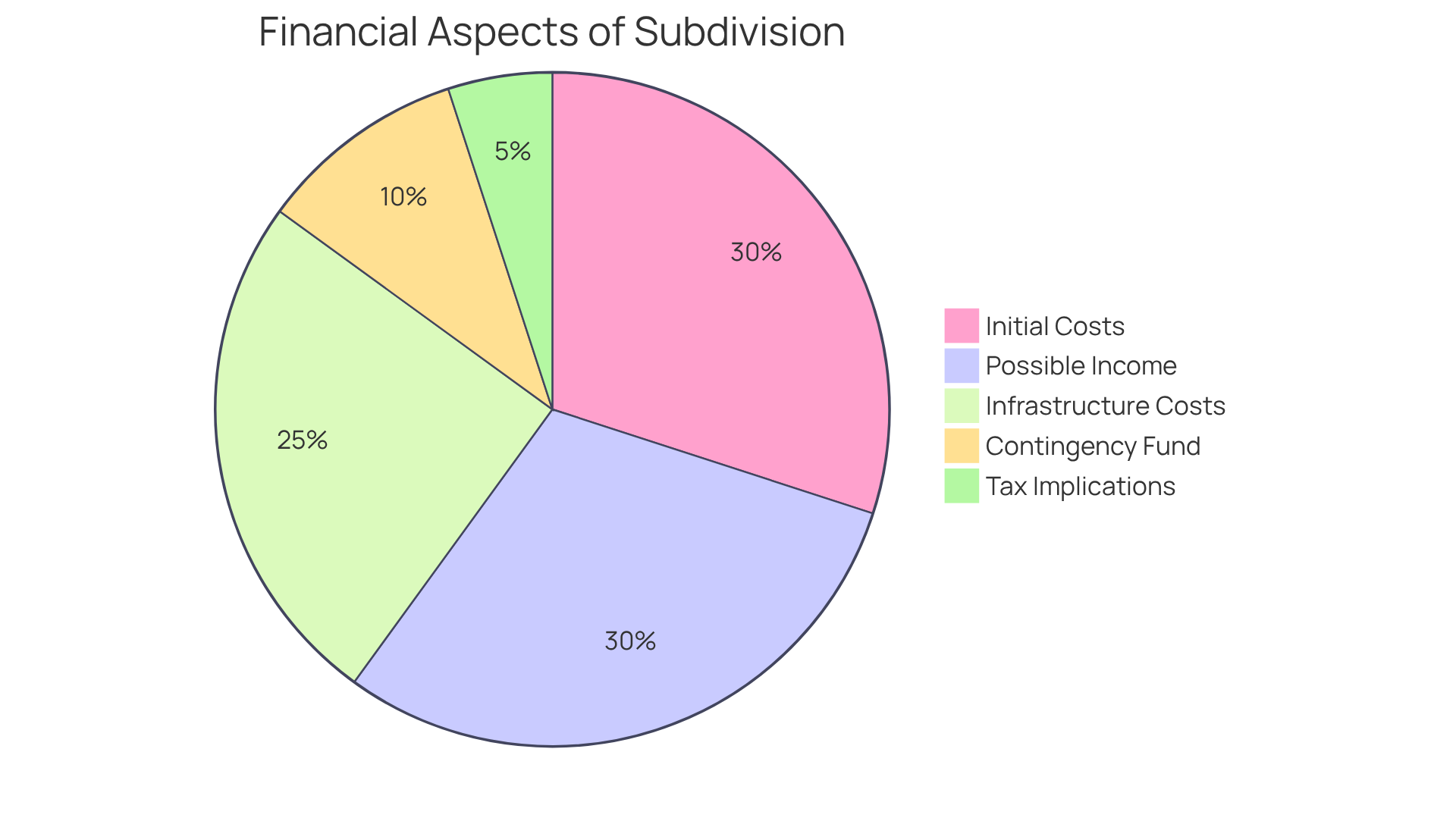
Utilize Technology for Efficient Title Research
Utilizing technology can significantly enhance the efficiency of title research during the subdivision stage. Consider the following tools and techniques:
-
Machine Learning: Employ machine learning algorithms to swiftly analyze extensive datasets of title documents, uncovering patterns and discrepancies that may not be immediately visible. This approach not only accelerates the research activity but also improves accuracy, enabling more informed decision-making. The anticipated growth of AI in various sectors underscores its significance in title research.
-
Optical Character Recognition (OCR): Implement OCR technology to transform scanned documents into editable and searchable formats. This capability significantly reduces the time spent on manual data entry, with studies indicating that "Overall, OCR can reduce the time spent on physical paperwork by 75 percent." By facilitating quick extraction of relevant information from title records, OCR streamlines the workflow.
-
GIS Mapping: Utilize Geographic Information Systems (GIS) for spatial data analysis, which aids in visualizing property boundaries and zoning classifications. This technology enhances understanding of land use and regulatory compliance, providing a clearer picture of property attributes. However, it is important to acknowledge that data complexity can pose challenges to AI adoption in this area.
-
Title Research Software: Invest in specialized title research software that automates various aspects of the title search procedure. Such tools minimize manual effort and increase accuracy, allowing title researchers to focus on higher-level analysis rather than routine tasks.
Integrating these technologies into your workflow not only streamlines the title research process but also ensures that all necessary information is gathered efficiently and accurately, ultimately leading to better outcomes in property transactions. Additionally, fostering trust in these AI systems is crucial for successful adoption and market acceptance.
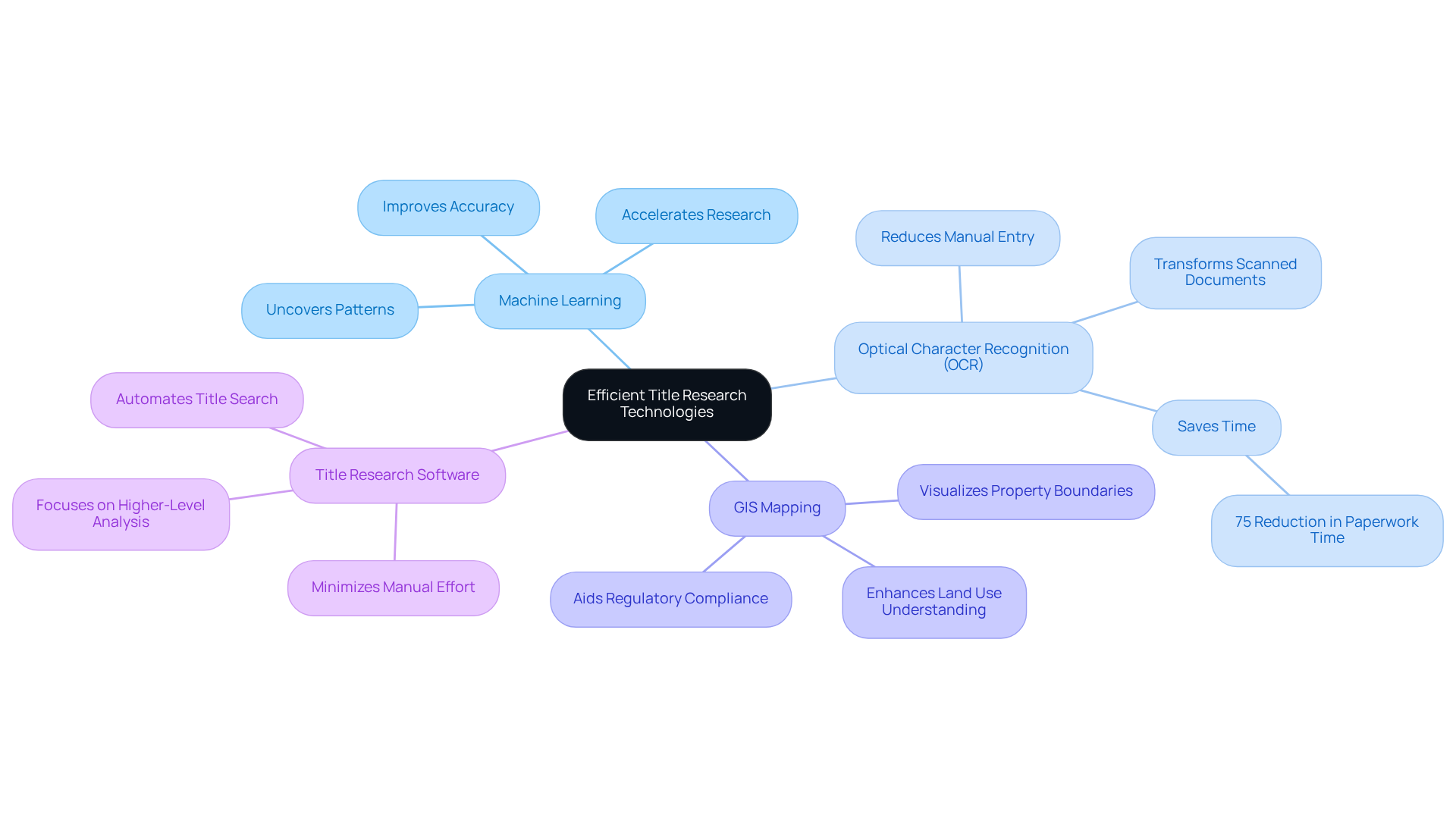
Conclusion
Mastering the overview of land parceling and subdivision is essential for anyone involved in real estate development. This process not only optimizes land use but also significantly enhances property value. Understanding the intricacies of subdividing land leads to informed decision-making and profitable outcomes, underscoring the importance of grasping the fundamentals, including zoning laws, legal requirements, and financial implications.
Throughout the article, key concepts were explored, such as:
- The step-by-step subdivision process
- The necessity of meeting legal and zoning requirements
- The evaluation of costs versus financial benefits
Furthermore, the discussion on utilizing technology for efficient title research highlights modern approaches that can streamline the subdivision process. Each of these elements plays a critical role in ensuring a successful subdivision that complies with regulations while maximizing potential revenue.
In conclusion, engaging with the land parceling and subdivision process is not merely about dividing land; it is about strategically navigating the complexities of real estate development. By understanding the necessary steps, legal considerations, and technological advancements, stakeholders can harness the full potential of land subdivision. This knowledge is vital for anyone looking to thrive in the real estate market, making it imperative to stay informed and proactive in applying these insights for future projects.
Frequently Asked Questions
What is land subdivision?
Land subdivision is a legal procedure that involves dividing a single parcel of land into two or more smaller sections for purposes such as sale, development, or other uses. It is essential for real estate development and can significantly enhance property value.
How long does the land subdivision process typically take?
The land division process typically requires 2 to 6 months to complete.
What are the typical costs associated with land subdivision?
The costs for land subdivision can range from $5,000 to over $50,000, depending on the location and infrastructure needs.
What are key terms related to land subdivision?
Key terms include: - Parcel: A defined piece of land that can be sold or developed. - Plat: A map that delineates the partition of terrain, illustrating the arrangement of lots, streets, and other features. - Zoning: Rules that dictate how territory can be utilized, impacting development opportunities.
What steps are involved in the land subdivision process?
The steps to successfully subdivide land include: 1. Conducting a feasibility study to evaluate compliance with local zoning laws. 2. Developing a subdivision plan that includes a plat map and infrastructure overview. 3. Obtaining required permits, such as a plat approval permit from local government. 4. Hiring professionals, including a surveyor and civil engineer, to assist with planning and surveying. 5. Submitting plans for approval to the local planning board and making necessary adjustments. 6. Completing the subdivision by filing the new plat with the local property records office.
Why is understanding land parceling and subdivision important for real estate professionals?
A thorough understanding of land parceling and subdivision is crucial for real estate professionals as it helps them navigate the complexities of the subdivision process, leading to more profitable outcomes and informed decision-making.




